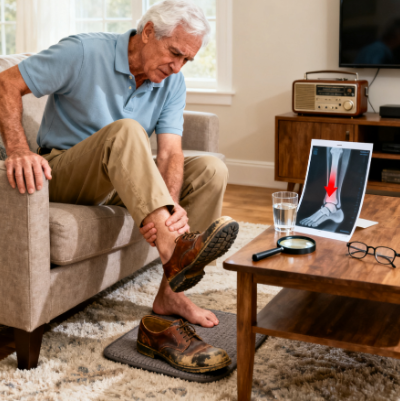
This Type of Shoe Most People Wear Daily Can Cause Pain in Your…
You slip them on every morning without a second thought. They’re comfortable, convenient, and go with everything in your closet. They might be your favorite pair of flexible sneakers, those lightweight slip-ons, or the worn-in flats you’ve had for years. You’ve walked miles in them, believing you’re giving your feet a treat. But what if this daily shoe choice is secretly contributing to nagging pain that extends far beyond your feet—pain in your knees, hips, and lower back?
For those of us in our 50s, 60s, and beyond, our feet naturally change. The protective fat pads on the soles thin out, arches can flatten, and we need more stability. The shoes that served us well in our 40s might be undermining our comfort and mobility now. The most common culprit isn’t high heels—it’s the shoe most people consider the epitome of comfort: flimsy, unsupportive shoes with thin, flexible soles.
The Problem with Being “Too Flexible”
It seems counterintuitive. Shouldn’t a flexible shoe allow your foot to move naturally? In theory, yes. But when a shoe offers no structural support or cushioning, it places an enormous strain on your entire musculoskeletal system. Think of walking on a thick, supportive carpet versus walking directly on a concrete floor. A flimsy shoe is like that concrete floor—it provides no shock absorption.
Here’s what happens with every step you take in an unsupportive shoe:
- Lack of Arch Support Leads to Chain Reaction: Without proper arch support, the arch of your foot collapses inward with each step (a motion called overpronation). This causes your ankle to roll inward, which in turn twists the shin bone, putting abnormal stress on the knee joint. This misalignment continues upward, affecting the hip and the alignment of your pelvis, often resulting in lower back pain.
- Insufficient Cushioning Sends Shockwaves Upward: The heel strike during walking creates a force that travels up your body. A shoe with a thin, worn-out sole does nothing to absorb this shock. Your joints—ankles, knees, and hips—are forced to handle the impact, leading to wear-and-tear pain, especially if you already have some arthritis.
- No Heel Counter Leads to Instability: The “heel counter” is the firm cup at the back of the shoe that stabilizes your heel. In flimsy shoes, this is often soft or nonexistent. This allows your heel to wobble side-to-side with each step, again contributing to misalignment and instability that your muscles then have to work overtime to correct, leading to fatigue and pain.
The Pain You Feel Isn’t Always in Your Feet
You might not even feel pain in your feet. The problem often manifests elsewhere because your body compensates for the poor foundation. You might experience:
- Knee Pain: Particularly on the inner side of the knee, due to the stress from the collapsing arch.
- Hip Pain: The hip muscles have to work harder to stabilize the leg, leading to bursitis or general ache.
- Lower Back Pain: The pelvic misalignment caused by the foot collapse puts strain on the muscles and joints of the lower back.
- Plantar Fasciitis: A sharp, stabbing pain in the heel, often felt with the first steps in the morning, caused by inflammation of the tissue that supports the arch.
How to Choose a Truly Supportive Shoe
You don’t have to sacrifice style for comfort. You just need to be a smarter shopper. Here’s what to look for:
- The “Twist” Test: Grab the shoe at the toe and heel and try to twist it. A good supportive shoe will resist twisting. If you can easily wring it like a towel, it’s too flimsy.
- The “Bend” Test: Press the toe of the shoe upward. It should bend only at the ball of the foot (where your foot naturally bends). If it bends freely in the middle of the sole, it lacks the necessary structural support.
- A Rigid Heel Counter: Squeeze the back of the shoe. It should be firm and not collapse easily.
- Good Arch Support: You should feel a noticeable bump on the inner side of the sole that cradles your arch, not a flat surface.
- A Thick, Cushioned Sole: Look for a sole with some substantial material that provides a barrier between your foot and the ground.
Your shoes are the foundation of your body. Wearing supportive, well-cushioned shoes is one of the simplest and most effective things you can do to protect your joints and stay active and pain-free. It’s not just about foot comfort—it’s about preserving your ability to walk comfortably, garden, travel, and play with your grandchildren for years to come. The right shoe isn’t an expense; it’s an investment in your mobility.